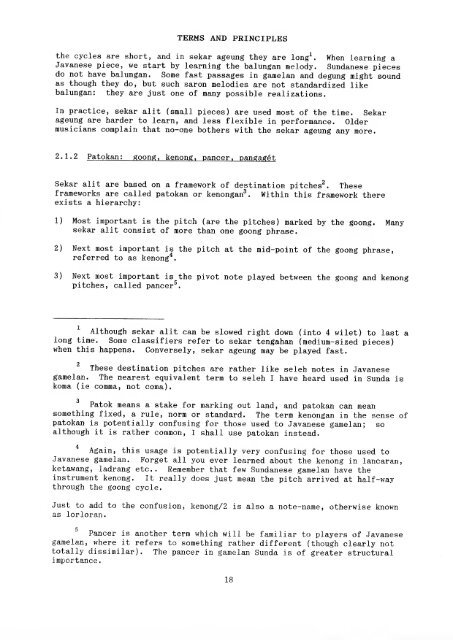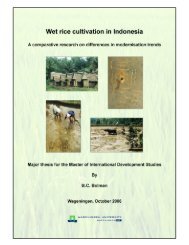Guide to Sundanese Music - Free EBooks Library
Guide to Sundanese Music - Free EBooks Library
Guide to Sundanese Music - Free EBooks Library
Create successful ePaper yourself
Turn your PDF publications into a flip-book with our unique Google optimized e-Paper software.
TERMS AND PRINCIPLES<br />
the cycles are short, and in sekar ageung they are long^. When learning a<br />
Javanese piece, we start by learning the balungan melody. <strong>Sundanese</strong> pieces<br />
do not have balungan. Some fast passages in gamelan and degung might sound<br />
as though they do, but such saron melodies are not standardized like<br />
balungan: they are just one of many possible realizations.<br />
In practice, sekar alit (small pieces) are used most of the time. Sekar<br />
ageung are harder <strong>to</strong> learn, and less flexible in performance. Older<br />
musicians complain that no-one bothers with the sekar ageung any more.<br />
2«1'2 Pa<strong>to</strong>kan; goong. kenong. pancer. pangag^t<br />
Sekar alit are based on a framework of destination pitches^. These<br />
frameworks are called pa<strong>to</strong>kan or kenongan^. Within this framework there<br />
exists a hierarchy:<br />
1) Most important is the pitch (are the pitches) marked by the goong. Many<br />
sekar alit consist of more than one goong phrase.<br />
2) Next most important is the pitch at the mid-point of the goong phrase,<br />
referred <strong>to</strong> as kenong'*.<br />
3) Next most important is the pivot note played between the goong and kenong<br />
pitches, called pancer^.<br />
Although sekar alit can be slowed right down (in<strong>to</strong> 4 wilet) <strong>to</strong> last a<br />
long time. Some classifiers refer <strong>to</strong> sekar tengahan (medium-sized pieces)<br />
when this happens. Conversely, sekar ageung may be played fast.<br />
2<br />
These destination pitches are rather like seleh notes in Javanese<br />
gamelan.<br />
koma (ie<br />
The nearest equivalent<br />
comma, not coma).<br />
term <strong>to</strong> seleh I have heard used in Sunda is<br />
Pa<strong>to</strong>k means a stake for marking out land, and pa<strong>to</strong>kan can mean<br />
something fixed, a rule, norm or standard. The term kenongan in the sense of<br />
pa<strong>to</strong>kan is potentially confusing for those used <strong>to</strong> Javanese gamelan; so<br />
although it is rather common, I shall use pa<strong>to</strong>kan instead.<br />
Again, this usage is potentially very confusing for those used <strong>to</strong><br />
Javanese gamelan. Forget all you ever learned about the kenong in lancaran,<br />
ketawang, ladrang etc.. Remember that few <strong>Sundanese</strong> gamelan have the<br />
instrument kenong. It really does just mean the pitch arrived at half-way<br />
through the goong cycle.<br />
Just <strong>to</strong> add <strong>to</strong> the confusion, kenong/2 is also a note-name, otherwise known<br />
as lorloran.<br />
Pancer is another terra which will be familiar <strong>to</strong> players of Javanese<br />
gamelan, where it refers <strong>to</strong> something rather different (though clearly not<br />
<strong>to</strong>tally dissimilar). The pancer in gamelan Sunda is of greater structural<br />
importance.<br />
18








